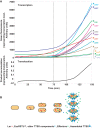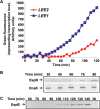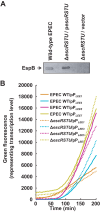Dynamics of expression and maturation of the type III secretion system of enteropathogenic Escherichia coli
- PMID: 24837293
- PMCID: PMC4135678
- DOI: 10.1128/JB.00069-14
Dynamics of expression and maturation of the type III secretion system of enteropathogenic Escherichia coli
Abstract
Enteropathogenic Escherichia coli (EPEC) is a major cause of food poisoning, leading to significant morbidity and mortality. EPEC virulence is dependent on a type III secretion system (T3SS), a molecular syringe employed by EPEC to inject effector proteins into host cells. The injected effector proteins subvert host cellular functions to the benefit of the infecting bacteria. The T3SS and related genes reside in several operons clustered in the locus of enterocyte effacement (LEE). We carried out simultaneous analysis of the expression dynamics of all the LEE promoters and the rate of maturation of the T3SS. The results showed that expression of the LEE1 operon is activated immediately upon shifting the culture to inducing conditions, while expression of other LEE promoters is activated only ∼70 min postinduction. Parallel analysis showed that the T3SS becomes functional around 100 min postinduction. The T3SS core proteins EscS, EscT, EscU, and EscR are predicted to be involved in the first step of T3SS assembly and are therefore included among the LEE1 genes. However, interfering with the temporal regulation of EscS, EscT, EscU, and EscR expression has only a marginal effect on the rate of the T3SS assembly. This study provides a comprehensive description of the transcription dynamics of all the LEE genes and correlates it to that of T3SS biogenesis.
Copyright © 2014, American Society for Microbiology. All Rights Reserved.
Figures





Similar articles
-
Bacterial-Chromatin Structural Proteins Regulate the Bimodal Expression of the Locus of Enterocyte Effacement (LEE) Pathogenicity Island in Enteropathogenic Escherichia coli.mBio. 2017 Aug 8;8(4):e00773-17. doi: 10.1128/mBio.00773-17. mBio. 2017. PMID: 28790204 Free PMC article.
-
Phenotypic diversity of type III secretion system activity in enteropathogenic Escherichia coli clinical isolates.J Med Microbiol. 2024 Oct;73(10):001907. doi: 10.1099/jmm.0.001907. J Med Microbiol. 2024. PMID: 39432330 Free PMC article.
-
Functional Characterization of EscK (Orf4), a Sorting Platform Component of the Enteropathogenic Escherichia coli Injectisome.J Bacteriol. 2016 Dec 13;199(1):e00538-16. doi: 10.1128/JB.00538-16. Print 2017 Jan 1. J Bacteriol. 2016. PMID: 27795324 Free PMC article.
-
Dynamics of expression, secretion and translocation of type III effectors during enteropathogenic Escherichia coli infection.Curr Opin Microbiol. 2020 Apr;54:67-76. doi: 10.1016/j.mib.2019.12.001. Epub 2020 Feb 12. Curr Opin Microbiol. 2020. PMID: 32058947 Review.
-
The Tip of the Iceberg: On the Roles of Regulatory Small RNAs in the Virulence of Enterohemorrhagic and Enteropathogenic Escherichia coli.Front Cell Infect Microbiol. 2016 Sep 21;6:105. doi: 10.3389/fcimb.2016.00105. eCollection 2016. Front Cell Infect Microbiol. 2016. PMID: 27709103 Free PMC article. Review.
Cited by
-
Engineering the Controlled Assembly of Filamentous Injectisomes in E. coli K-12 for Protein Translocation into Mammalian Cells.ACS Synth Biol. 2015 Sep 18;4(9):1030-41. doi: 10.1021/acssynbio.5b00080. Epub 2015 Jun 12. ACS Synth Biol. 2015. PMID: 26017572 Free PMC article.
-
Novel insights into the mechanism of SepL-mediated control of effector secretion in enteropathogenic Escherichia coli.Microbiologyopen. 2018 Jun;7(3):e00571. doi: 10.1002/mbo3.571. Epub 2017 Dec 26. Microbiologyopen. 2018. PMID: 29277965 Free PMC article.
-
The Role of the Small Export Apparatus Protein, SctS, in the Activity of the Type III Secretion System.Front Microbiol. 2019 Nov 13;10:2551. doi: 10.3389/fmicb.2019.02551. eCollection 2019. Front Microbiol. 2019. PMID: 31798543 Free PMC article.
-
Molecular basis for CesT recognition of type III secretion effectors in enteropathogenic Escherichia coli.PLoS Pathog. 2018 Aug 17;14(8):e1007224. doi: 10.1371/journal.ppat.1007224. eCollection 2018 Aug. PLoS Pathog. 2018. PMID: 30118511 Free PMC article.
-
Structural and Functional Characterization of the Bacterial Type III Secretion Export Apparatus.PLoS Pathog. 2016 Dec 15;12(12):e1006071. doi: 10.1371/journal.ppat.1006071. eCollection 2016 Dec. PLoS Pathog. 2016. PMID: 27977800 Free PMC article.
References
Publication types
MeSH terms
Substances
LinkOut - more resources
Full Text Sources
Other Literature Sources

